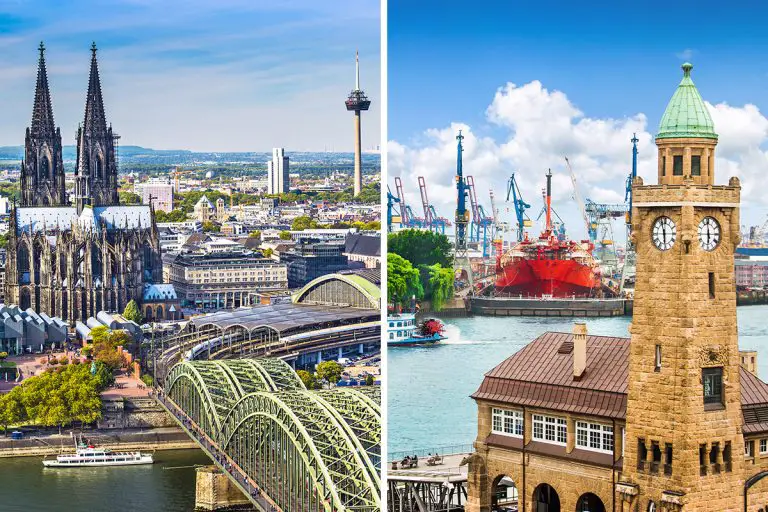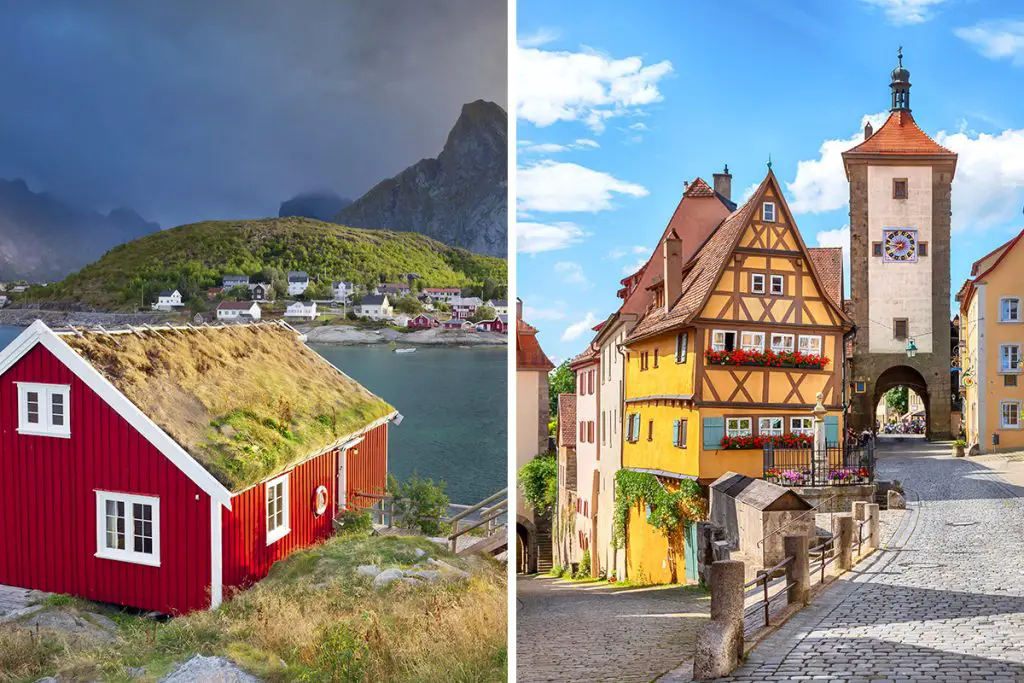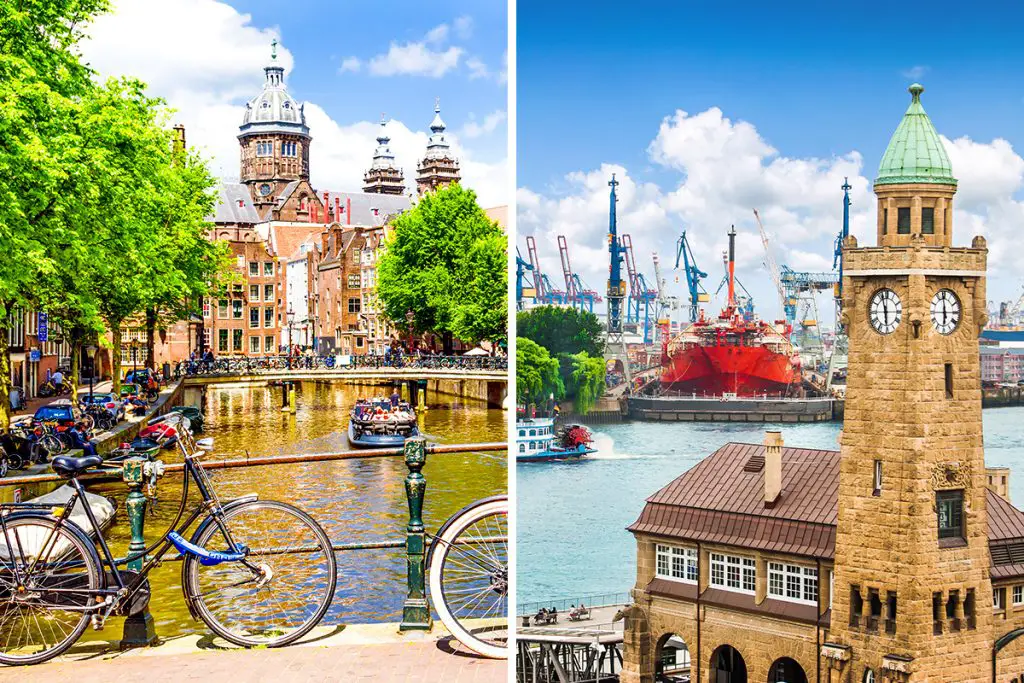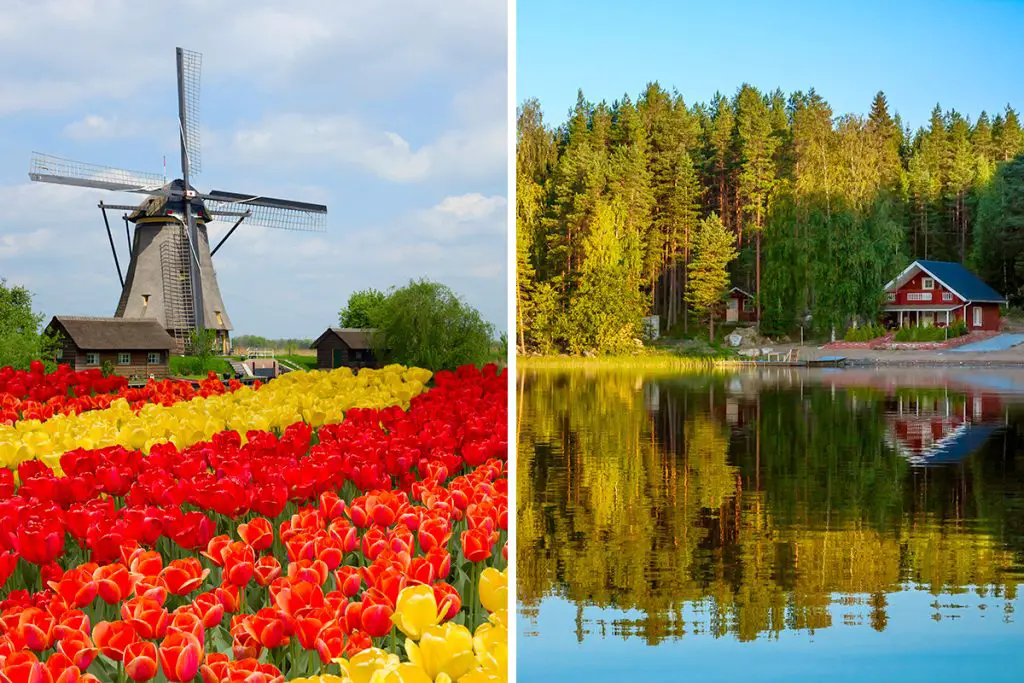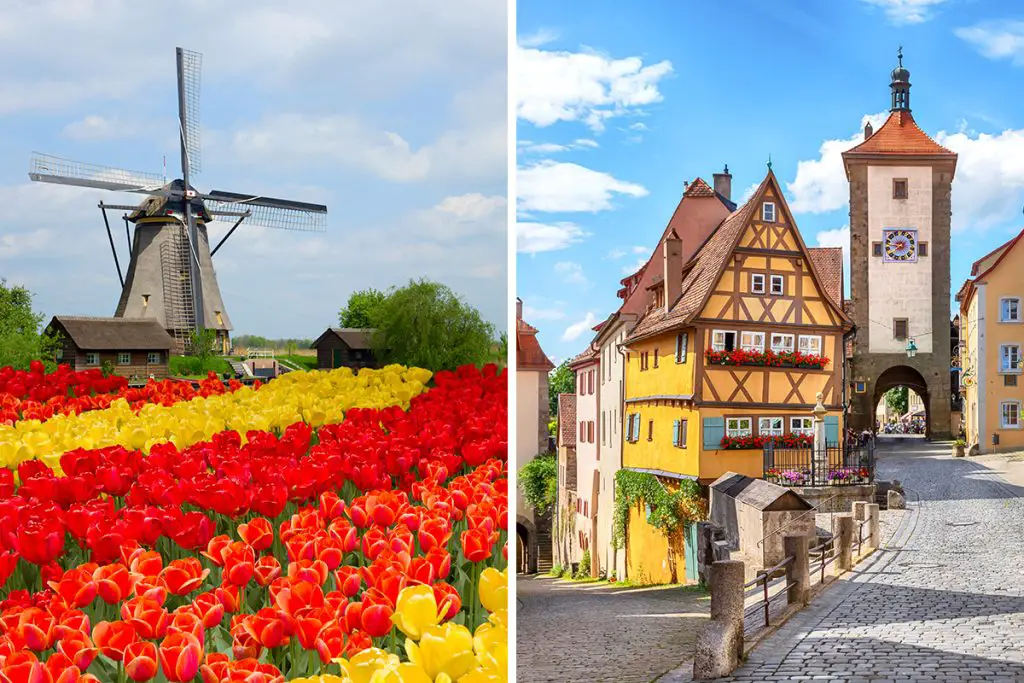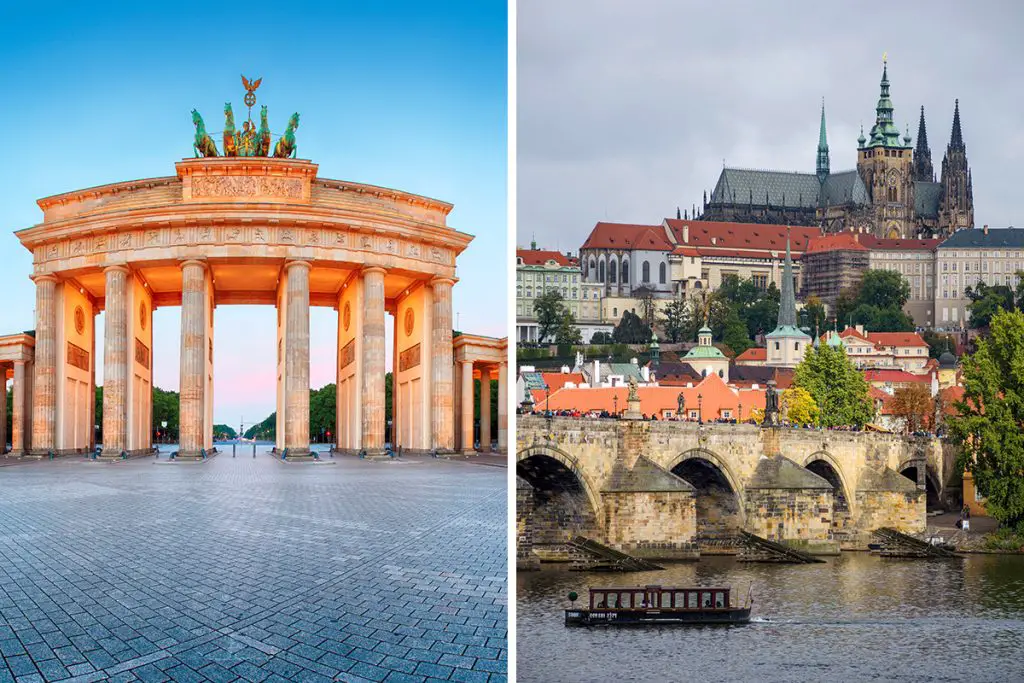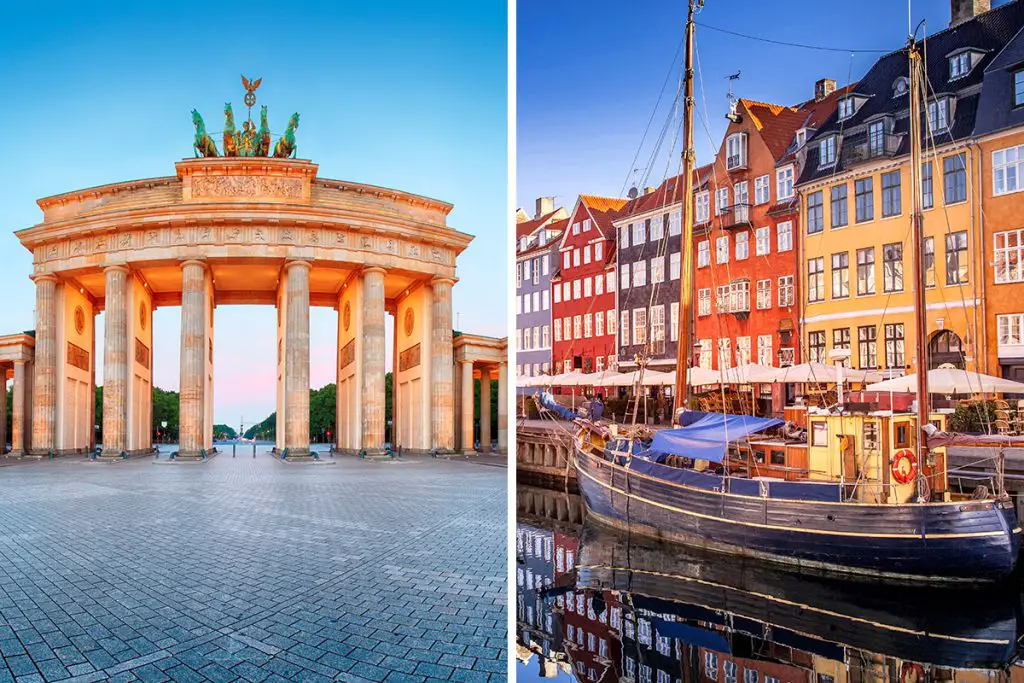These two German gems have unique tales to tell. Cologne, with its imposing cathedral and Roman heritage, sings a different tune than the harbor city of Hamburg with its vast shipyards and maritime traditions. Stick around and let’s dive into the intriguing pasts and the diverse cultural landscapes of these two captivating cities.
History & Culture
Embarking on the journey of comparing the histories and cultures of Cologne and Hamburg is akin to opening two treasure chests, each filled with unique stories, artifacts, and traditions.
Cologne, located on the banks of the Rhine River, can trace its roots back to the Roman Empire.
This ancient city is known for its blend of history and modernity. It prides itself on its glorious past, visible in its Roman ruins and the awe-inspiring Cologne Cathedral, a UNESCO World Heritage Site. At the same time, it’s a hub for contemporary art and hosts a variety of cultural festivals every year, celebrating the city’s vibrant diversity and creative spirit.
Hamburg, on the other hand, has a fascinating history as a vital member of the medieval Hanseatic League, an alliance of merchant cities that dominated trade in northern Europe.
The city’s location on the Elbe River near the North Sea made it a crucial seaport, helping it become one of the world’s largest shipping centers. Its seafaring past is reflected in its culture, from the unique architecture of its warehouses and merchant houses to its renowned maritime museum and love for sailing.
It’s truly a delight to witness how the cities’ histories shape their cultures. In Cologne, Roman history is alive in its architecture, festivals, and art, creating a cultural landscape that appreciates the past while embracing the future.
In contrast, Hamburg’s maritime roots have given it a distinct culture, where the sea is deeply woven into its way of life, influencing everything from architecture to recreational activities.
To summarize, while Cologne offers a colorful palette of Roman history mixed with a lively modern art scene, Hamburg’s culture is steeped in its seafaring past, resonating in its architecture, museums, and lifestyle. The question is: Which captivating story speaks to your soul the most? Do you find yourself drawn to Cologne’s Roman grandeur and artistic flair, or do Hamburg’s maritime traditions and sea-loving culture stir your interest?
Attractions & Activities
Exploring the numerous attractions and engaging in diverse activities is the key to understanding the essence of both Cologne and Hamburg. Unraveling their distinct vibes and unique flavors through various landmarks and experiences is quite the adventure.
In Cologne, the iconic Cologne Cathedral (Kölner Dom) steals the spotlight. This towering Gothic masterpiece, which stands 157.38 meters (516 feet) tall, took over 600 years to complete. A climb up to the top promises a breathtaking panoramic view of the city.
Next, Museum Ludwig is a paradise for modern art enthusiasts, housing an impressive collection of works from Picasso, Warhol, and many other artists. If you’re looking for outdoor activities, taking a leisurely cruise along the Rhine River is a beautiful way to soak up Cologne’s scenic beauty.
Meanwhile, Hamburg’s attractions offer a different experience. The Miniatur Wunderland, the world’s largest model railway, is an absolute must-visit. It’s an awe-inspiring marvel of intricate details and creative storytelling.
Next, the Elbphilharmonie, Hamburg’s stunning concert hall with its unique wave-like structure, is not just for music lovers. The Plaza, a public viewing area, gives you a 360-degree view of the city and its harbor. Lastly, a boat tour around Hamburg’s bustling port will give you a taste of the city’s strong maritime roots.
In conclusion, both cities present a range of attractions and activities that cater to a variety of interests. Cologne combines religious grandeur, modern art, and a beautiful riverside experience, while Hamburg impresses with its model marvels, architectural beauty, and dynamic harbor experience. Your choice depends on what kind of adventure captivates your imagination the most.
Eating, Drinking & Nightlife
The flavors of a city and its after-dark pulse often provide an intriguing glimpse into its soul. Let’s embark on a gastronomic journey through Cologne and Hamburg, coupled with a dive into their lively nightlife.
When it comes to food, Cologne is known for its hearty and traditional dishes. The city’s signature dish is the ‘Himmel un Äd’, a rustic combination of black pudding, mashed potatoes, and applesauce. Another must-try is the ‘Halve Hahn’, a rye roll with Gouda cheese, pickles, and onions.
In contrast, Hamburg’s food scene is synonymous with seafood. As a port city, it has easy access to fresh catches, and the local delicacy ‘Fischbrötchen’, a fish sandwich, is a testament to this. ‘Labskaus’, a sailor’s dish made with corned beef, potatoes, and beetroot, is another unique dish to experience in Hamburg.
Regarding drinks, Cologne takes pride in its ‘Kölsch’, a top-fermented beer exclusive to the city. Served in small, slender glasses, it’s a must-try when you visit. Conversely, Hamburg is famous for its ‘Alsterwasser’, a refreshing mix of beer and lemonade.
Nightlife in Cologne is bustling and diverse. The city’s party hub is the ‘Zülpicher Straße’, where you can find bars and clubs to suit all tastes. In Hamburg, the ‘Reeperbahn’, a street in the St. Pauli district, is the center of nightlife with its countless clubs, bars, and music venues.
To wrap up, the culinary, drinking, and nightlife experiences in Cologne and Hamburg each have their distinct character. While Cologne tempts with hearty cuisine, local beer, and a vibrant street party scene, Hamburg offers fresh seafood delights, unique drinks, and an exciting neighborhood brimming with nightspots.
Shopping
The joy of shopping can be quite different from one city to another. Let’s compare the shopping experiences Cologne and Hamburg have to offer.
Cologne’s shopping scene is marked by the ‘Schildergasse’, a popular shopping street in the city center. This pedestrian-friendly zone is home to both international brands and local boutiques. Not far away, the ‘Belgian Quarter’ (Belgisches Viertel) is known for its trendy boutiques and design shops, making it a favorite among fashion-forward shoppers.
Hamburg, on the other hand, offers ‘Mönckebergstraße’ and ‘Spitalerstraße’, two bustling shopping streets filled with a variety of shops and department stores. For more exclusive and high-end shopping, ‘Neuer Wall’ is the go-to destination, with its luxury brands and designer labels.
In summary, whether you’re after international brands, local boutiques, or high-end luxury items, both Cologne and Hamburg offer a variety of shopping experiences. Cologne’s Schildergasse and Belgian Quarter cater to a broad spectrum of shoppers, while Hamburg’s Mönckebergstraße, Spitalerstraße, and Neuer Wall offer everything from variety shopping to exclusive splurges. The choice of shopping venue largely depends on what kind of retail therapy you’re seeking.
Accommodation
Your stay in a city can be as important as the city itself. The choice between Cologne and Hamburg can present a variety of accommodations to cater to different preferences.
In Cologne, you’ll find a range of options from budget-friendly hostels to luxury hotels. The Altstadt (Old Town) is a popular area to stay, offering proximity to major attractions like the Cologne Cathedral and the Rhine River. For those who appreciate a trendier vibe, the Belgian Quarter is home to chic boutique hotels and hip B&Bs.
Conversely, in Hamburg, the city’s accommodation ranges from quaint guesthouses to upscale establishments. The HafenCity area, with its modern, sustainable architecture, offers several luxury hotels with harbor views. For budget-conscious travelers, the St. Pauli district provides a variety of affordable hostels and guesthouses.
In conclusion, whether you’re looking for luxury, charm, or affordability, both Cologne and Hamburg have a diverse range of accommodations to suit your needs. The choice really comes down to whether you prefer the historical ambiance of Cologne’s Old Town, the trendy atmosphere of its Belgian Quarter, or the maritime allure of Hamburg’s HafenCity and the colorful vibrancy of St. Pauli.
Family-Friendliness & Children’s Activities
Traveling with family requires careful consideration of the activities and amenities a city has to offer. Let’s compare how Cologne and Hamburg stack up in terms of being family-friendly and the children’s activities available.
Cologne is a family-friendly city with plenty to keep children engaged. The Cologne Zoo, with its diverse range of animals and a large playground, is a must-visit. Similarly, the Chocolate Museum offers interactive exhibits where children can learn about chocolate making.
Meanwhile, Hamburg also boasts a multitude of child-friendly activities. Miniatur Wunderland is a delight for kids with its vast model railway and intricate miniature scenes. The Tierpark Hagenbeck, Hamburg’s zoo, combines animal encounters with a large playground and a prehistoric park featuring life-sized dinosaur models.
To conclude, both Cologne and Hamburg provide a variety of activities that will captivate children. Cologne’s zoo and interactive Chocolate Museum, and Hamburg’s Miniatur Wunderland and zoo, all offer unique experiences that are sure to entertain the entire family. The choice depends on your family’s specific interests.
Getting There & Getting Around
Navigating to and around a new city is a significant part of any travel experience. So, let’s compare the journey to and the means of getting around in Cologne and Hamburg.
Getting to Cologne is straightforward, with the Cologne Bonn Airport located approximately 15 kilometers (9.3 miles) southeast of the city. High-speed trains also connect Cologne with major cities in Germany and across Europe.
Hamburg, in contrast, is served by Hamburg Airport, situated about 9 kilometers (5.6 miles) north of the city. It’s also well-connected to Germany’s extensive railway network.
Once in Cologne, the city’s public transportation system, including trams, buses, and the S-Bahn (suburban train), makes it easy to explore the city. A highlight is the Cologne Cable Car, providing an aerial view of the city while crossing the Rhine.
In Hamburg, the public transportation network of buses, S-Bahn, and U-Bahn (underground railway) is efficient and far-reaching. Boat services on the Alster Lake and Elbe River offer a unique way to get around and see the city.
In summary, whether you choose Cologne or Hamburg, getting there and getting around is straightforward and convenient, with well-connected airports and extensive public transportation networks. The final decision may rest on whether you prefer the charm of a cable car ride over Cologne or the thrill of a boat ride on the Elbe River in Hamburg. Both cities offer unique and enjoyable ways to experience their culture and scenery.
Weather
Weather can greatly influence your travel experience. So, it’s important to compare the climate in Cologne and Hamburg to know what to expect.
Cologne has a temperate oceanic climate. Summers (June to August) are warm, with temperatures typically ranging between 66°F to 77°F (19°C to 25°C). Winters (December to February) can be chilly, with temperatures hovering around 32°F to 41°F (0°C to 5°C).
In contrast, Hamburg’s climate is maritime temperate, meaning the weather is moderated by the nearby sea. The summers are slightly cooler than Cologne, with temperatures around 60°F to 70°F (15°C to 21°C). Winters are similar, averaging between 32°F to 39°F (0°C to 4°C).
To summarize, both Cologne and Hamburg experience mild, pleasant summers and cooler winters. The main difference is that Cologne’s summers are slightly warmer. Your preference between a warmer summer or a slightly cooler, sea-influenced climate will help determine the best time to visit each city.
Safety
Safety is a primary concern when traveling. Let’s take a look at the safety aspects of Cologne and Hamburg.
Both Cologne and Hamburg are generally considered safe for tourists. Like any other city, there can be instances of petty crime such as pickpocketing in crowded areas or public transportation, but these are not widespread.
In terms of unique, non-crime-related safety aspects, Cologne and Hamburg both have well-organized emergency services. Furthermore, both cities take pride in their efficient public transportation systems that adhere to strict safety standards.
In conclusion, while it’s always crucial to take basic safety precautions wherever you travel, both Cologne and Hamburg are safe cities with low crime rates and efficient public systems. The choice between the two would not significantly impact the safety aspect of your trip.
Cost
Budgeting is an important part of planning any trip. Let’s compare the costs associated with visiting Cologne and Hamburg.
In terms of accommodation, an average hotel room in Cologne can cost around 90 euros ($105), whereas in Hamburg, you can expect to pay around 100 euros ($117) per night.
When it comes to dining, a meal at an inexpensive restaurant in Cologne is typically around 10 euros ($12), and in Hamburg, it’s around 12 euros ($14). For transportation, a one-way ticket on public transport costs approximately 3 euros ($3.5) in both cities.
In conclusion, while the costs in both Cologne and Hamburg can vary depending on your personal preferences and travel style, they are relatively similar. Hamburg can be slightly more expensive in terms of accommodation and dining, but the difference is not substantial. As such, your choice between the two cities might be more influenced by the type of experiences and attractions you seek rather than the cost.
Which Is Better – Cologne or Hamburg?
As we near the end of our comparison journey, we have touched on a variety of factors that make both Cologne and Hamburg unique and appealing in their own ways.
When we delve into the history and culture of these two cities, we find that Cologne, with its ancient Roman history and iconic Cologne Cathedral, offers a rich and deeply layered cultural experience. In contrast, Hamburg, with its maritime heritage, vibrant music scene, and abundance of museums, provides a dynamic and diverse cultural experience.
Attractions and activities in both cities are aplenty. Cologne offers a mix of historical sites, beautiful parks, and modern architecture, while Hamburg offers an array of outdoor activities, iconic structures like the Elbphilharmonie, and exciting boat tours around its vast harbor.
Cologne’s inland location doesn’t offer beaches. However, the city makes up for it with its diverse attractions and activities. On the other hand, Hamburg, with its proximity to the North Sea, provides opportunities for beach outings, especially during the warmer months.
Both cities are well-regarded for their food and drink scene, but Hamburg stands out with its seafood-oriented cuisine and lively beer gardens. When it comes to shopping, Hamburg’s upscale boutiques and large shopping centers contrast with Cologne’s eclectic mix of modern malls and quirky vintage shops.
For accommodations, both cities offer a range of options, from luxury hotels to budget-friendly hostels. As for family-friendliness and children’s activities, both cities score high with their variety of parks, museums, and kid-friendly attractions.
In terms of getting there and around, both cities boast excellent public transportation networks. Cologne and Hamburg have well-connected airports and train stations, making travel to and from these cities quite convenient.
Weather-wise, Cologne tends to have slightly warmer summers, while Hamburg offers a cooler, sea-influenced climate. Both cities are generally safe to visit with low crime rates and well-organized public services. Finally, in terms of cost, Hamburg is slightly more expensive than Cologne, but the difference is not substantial.
In conclusion, your choice between Cologne and Hamburg largely depends on what you are seeking from your trip. If you’re looking for a rich historical experience, slightly warmer weather, and a vibrant food and drink scene, then Cologne might be the better choice.
However, if you prefer a seaside city with a dynamic cultural scene and diverse shopping options, and don’t mind a slightly higher cost, then Hamburg might be the city for you. Both cities offer unique experiences that cater to a wide range of preferences, making them both fantastic travel destinations.

